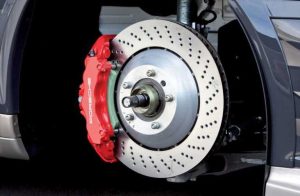The braking system is one of the most critical components of any vehicle. Yet despite its importance, many drivers continue to hold outdated or incorrect beliefs about how brakes work and how to maintain them properly. These myths can lead to poor driving habits, unnecessary repairs, or even dangerous situations on the road. In this article, we’ll debunk some of the most common braking system myths and provide the facts every driver should know.
Why Brake System Knowledge Matters

Misunderstanding how your brakes function can result in:
-
Increased wear and tear
-
Reduced braking performance
-
Unsafe driving conditions
-
Higher maintenance costs
Arming yourself with accurate information can help extend the life of your brake components and improve road safety for everyone.
Common Brake System Myths vs. Facts
Here’s a breakdown of the most persistent brake myths and the reality behind them:
| Myth | Fact |
|---|---|
| “Brakes stop the car.” | Tires stop the car — brakes stop the wheels; traction does the rest. |
| “ABS reduces braking distance on all surfaces.” | ABS helps maintain control, but may increase distance on loose surfaces. |
| “Brake fluid never needs to be changed.” | Brake fluid absorbs moisture and must be changed regularly. |
| “Squeaky brakes always mean something is wrong.” | Not always — dust, moisture, or cheap pads can cause squeaks. |
| “More expensive brake pads always last longer.” | Longevity depends on materials and driving style, not just price. |
| “If the brakes feel fine, they don’t need service.” | Many brake problems are silent — regular inspections are key. |
| “Rear brakes are less important.” | Rear brakes handle significant load and are critical to balance. |
Myth #1: Brakes Stop the Car
Truth: Brakes slow the rotation of your wheels, but it’s actually the friction between your tires and the road that brings your car to a halt. If your tires are bald or the road is icy, no amount of braking force will stop your car quickly.
What to Do:
-
Ensure tires are in good condition.
-
Avoid relying solely on brake upgrades without addressing tire traction.
Myth #2: ABS Shortens Stopping Distance in All Conditions
Truth: The anti-lock braking system (ABS) is designed to help drivers maintain steering control during hard braking, especially on slippery surfaces. However, on gravel or snow, ABS can increase stopping distances because it prevents wheel lock-up.
Key Benefits of ABS:
-
Prevents skidding
-
Maintains control during emergency braking
-
Does not guarantee shorter stop on every surface
Myth #3: Brake Fluid Is a Lifetime Fluid
Truth: Brake fluid is hygroscopic — it absorbs moisture from the air over time. This reduces its boiling point, which can lead to brake fade under heavy use.
Recommended Service:
| Brake Fluid Type | Change Interval |
|---|---|
| DOT 3 / DOT 4 | Every 1.5–2 years |
| DOT 5 (Silicone) | Longer-lasting, but rare |
Myth #4: All Brake Noise Means Trouble
Truth: Not every noise is a sign of failure. Brake pads can squeak due to:
-
Moisture in the air
-
Dust or dirt buildup
-
Pad material composition
When to Be Concerned:
-
Grinding sounds
-
Noise persists after warming up
-
Pulling or vibration during braking
Myth #5: Premium Pads Always Last Longer
Truth: The lifespan of brake pads depends on material and usage—not just price. For example:
-
Ceramic pads offer long life and low dust, but aren’t ideal for high-performance braking.
-
Semi-metallic pads provide better heat dissipation but can wear rotors faster.
| Pad Type | Best For | Wear Rate |
|---|---|---|
| Ceramic | City driving, daily commute | Low |
| Semi-metallic | High-speed, performance cars | Medium–High |
| Organic | Older or light-duty vehicles | High |
Myth #6: If It Feels Fine, It’s Fine
Truth: Many brake issues develop gradually and aren’t immediately noticeable. Problems like uneven pad wear, caliper binding, or rotor warping can silently reduce performance over time.
Diagnostic Checklist:
-
Have brakes inspected every 10,000–15,000 km
-
Monitor brake fluid condition
-
Don’t wait for warning lights to act
Myth #7: Rear Brakes Don’t Matter as Much
Truth: While front brakes do more work due to weight transfer, rear brakes are essential for balance and vehicle stability. Neglecting rear brakes can lead to:
-
Poor stopping power
-
Increased wear on front components
-
Compromised vehicle handling
Tip: Always service brakes as a complete system for consistent performance.
Brake Maintenance Do’s and Don’ts

Do:
-
Replace pads before they wear down completely
-
Use the correct type of brake fluid
-
Service both front and rear brakes
-
Listen to unusual sounds during braking
-
Get professional inspections at regular intervals
Don’t:
-
Ignore brake warning lights
-
Mix different types of brake fluids
-
Delay service if your brake pedal feels soft or spongy
-
Assume ABS is foolproof in every condition
Trusted Source for Brake Parts
Avoid falling for myths that can lead to poor part selection. If you’re replacing or upgrading brake components, always choose parts from reputable suppliers.
Buy Brake System online — quality parts, expert support, and fast delivery.
Conclusion
Understanding how your braking system truly works is essential for staying safe and saving money. Myths can lead to false assumptions that compromise both performance and safety. By learning the facts, performing regular maintenance, and choosing quality parts, you can ensure your vehicle stops when and how it should—every time.
Stay informed. Stay safe. And when in doubt, consult a qualified technician.